Adios, Cowboy: The Last Jam
I’ve spent the last four months asking the same question of Cowboy Bebop: why? In turn, I expect the people reading this series (all six of them) have asked the same question of me. Why write more than 35,000 words on a twenty-year-old TV show to spend 25,000 of those words trying to dunk on it. Am I so insecure that I need to shit on something people love as a means of making myself feel like the big man on campus? Am I so desperate for attention that I will take a page out of the Republican Party playbook and talk trash until someone notices me? I know people have asked these questions of me, because I’ve asked them of myself.
Who am I as a hack writer to question the value of a show that has, for the last twenty years, enshrined itself as anime reaching the level of high art? If you’ve stuck with me this long, perhaps you’ll hang on for a few more paragraphs as I account for myself and this review series. I want to answer why. In doing so, I want to explore how one might muddle something that is aspirational with something that is inspirational.
When I was a teenager I wanted to write something like Macross Plus. On the heels of Harmony Gold underwriting Robotech with kid-friendly cheese (if you don’t believe me, close your eyes and listen to the dialogue of any episode of Robotech) Macross Plus was giving me the harder edge that I thought made everything better. Macross Plus had more violence, more sex appeal, cooler music, and more interpersonal drama, all of which resonated with me as a reclusive teenager.
Skip ahead to my fourth year of university, and I’m watching Macross Plus with the woman I was dating. We get to the part where we find out that Guld assaulted Myung when they were teenagers. She looks at me and asks, “this is one of your favourite things?” I nod. She asks, “why does a woman have to get raped for this story to work?”
I’d be lying if I said I heard what she was asking in that moment. It took me a hell of a lot longer than the span of that relationship to understand that even though Macross Plus inspired me to write certain things, I was never going to grow as a writer if I kept aspiring to the techniques that made it work. Let me show my math: the first novel I ever wrote, one that is never coming out of the trunk, only makes space for women characters as vectors to inform the angst and pain of the male protagonist. Aspiring to be like Macross Plus limited my capacity to tell a good story.
I have no doubt that Cowboy Bebop inspired countless people to tell great stories. But is it really something that the uninitiated should aspire toward in terms of theme, form, and technique? The whole purpose of this review series was to answer a simple question: what can Cowboy Bebop teach contemporary writers? As I stand in the metaphorical ashes of Spike’s funeral pyre, I think the most important lesson in this series is on the dangers of being too in love with our own backstories.
If we aspire to write in the fashion of Cowboy Bebop, we are saying that set dressing, world building, and mystery boxes are more important than conflict, character growth, and agency. I am the first to admit that I was amazed to see Asteroid Blues work without having any character agency. I loved what that episode did. Indeed, it gave me high hopes for the rest of the series. However, I thought the experimental nature of the show would evolve, not wallow. To that end, it took four episodes for story telling absent agency to turn me against the show. I demand more than amazing backdrops and the promise of a deeper game.
In deference to those backdrops, I’d be lying if I said I didn’t want to walk around in Cowboy Bebop’s world. Our first look at Mars as a cosmopolitan and human space was ahead of its time. When depictions of Mars to that point were rooted in a handful of traditions, most of which pivoted between Burroughs’ Barsoom or the corporate brutalism of Total Recall, Bebop’s Mars was something new and wonderful. I can understand why Vicious wanted to turn himself into the second coming of Alexander of Macedon; he lived in a world of endless worlds and stories. Yet this strength of setting only rubbed salt in my wounds. It painted Rembrandts of world building and then reduced them to back drops for the same narrative routine; to wit, Cowboy Bebop’s power move is having the characters fall ass backwards into somebody else’s story before lighting up a cigarette once that conflict resolved itself without the Bebop crew having to do anything. That’s not storytelling; it’s high-concept wanking.
Bebop reminds me of how I wrote when I was a teenager. It reminds me of the days when I didn’t understand that theme, generally, emerges out of conflict. That a setting, typically, exists to serve the story, not become the story. Those were days when I wouldn’t write a story without drafting the constitution of the space civilization that I invented in the story. Nothing about the story demanded such a level of detail. Additionally, it was a hell of a lot easier to faff about in stage design rather than give my characters a problem to solve. Writing is hard that way.
So I can see how Bebop inspired everybody who saw it to want to shape glorious worlds of their own. I can also see how it convinced some people that they were above criticism so long as they were breaking the rules.
Even though Cowboy Bebop failed to live up to the hype, I think there’s still some good parts to its story. With that in mind, I have prepared an abridged viewing order that captures the important beats while forcing an inherently chaotic series into something that resembles an arc.
Cowboy Bebop: The Shaftoe Viewing Order
Session 1: Stray Dog Strut: Faye doesn’t really need an introduction. She can just show up and the audience will learn all they need to know about her. Ein, however, has to have his context established in a more overt way. We need to know that he is a data dog as grounds for suspending disbelief about his near-human level of intelligence.
Session 2: Waltz for Venus: This is one of the few episodes where the Bebop crew actually do things, rather than have things happen to them. It’s also one of the few episodes where the gang manage to land a bounty. The ethos of Cowboy Bebop might be rooted in failure, but endlessly repeating the failure is dull. In contrast, seeing the crew do well is a much more satisfying experience. Likewise, Roco is one of the few genuinely good characters in the show, and his dying despite Spike’s efforts to keep him alive sets the tone for life being cheap in the Bebop setting.
Session 3: Ballad of the Fallen Angel: This remains one of the best episodes of the series. Everything it does, it does well, except for all the stupid anime tit bondage fan service. Every subsequent entry into Vicious’ arc gets measured against Ballad. The trick here is condensing Vicious’ story into something that unfolds at a pace that makes Julia feel like less of a prop and Spike seem like less of a mad man.
Session 4: Jamming with Edward: Waiting nine episodes to bring Ed into the fray was a mistake. I am correcting that mistake.
Session 5 and 6: Jupiter Jazz: Waltz for Venus establishes that Faye is a complete shit show of a human being. Diving into these two episodes right after Ed comes aboard the ship keeps up that momentum, while also demonstrating what Ed can do as a hacker. A single episode gap between Julia’s introduction and Spike running off to look for her on Callisto gives his actions more continuity.
Session 7: My Funny Valentine: Cowboy Bebop might not do much in terms of sticking the landing on Faye’s exit and return to the Bebop, but the suffering of her post-cryo life hits with a certain kind of resonance. Even if Spike’s story hijacks Faye’s overall redemption in this series, this single episode puts character into context.
Session 8: Bohemian Rhapsody: I want another Ed episode, and I refuse to put Mushroom Samba on this list. Moreover, I’m trying to focus on the episodes where the Bebop crew are active players in the story, rather than passive weirdos who have the story move around them. Finally, Faye isn’t complete garbage in this story, so its inclusion shapes her upward trajectory.
Session 9: Brain Scratch: This is one of the best non-Vicious episodes. It shows Jet, Ed, and Ein having their own adventure, and it is one of the few episodes that gets better, rather than more flimsy, on a second viewing. It also a perfect lead-in to Faye wanting to reclaim her pre-cryo life.
Session 10: Hard Luck Woman: If we are going to fall in love with Ed and Ein, then I want their leaving to hurt, and there’s no way to do that without having Hard Luck Woman in the list. And since we’re cutting out most of the episodes where the writing hits the big red reset button, Faye’s return for the Real Folk Blues doesn’t feel quite tedious and contrived.
Session 11 and 12: The Real Folk Blues: Even with a viewing order that is cut down to less than half of the original run, I still think that Julia is going to come off more like a prop and less like a real person in TRFB. But if my viewing order does anything, it underscores how Cowboy Bebop wants the audience to see life as fleeting and cheap. Simultaneously, condensing Vicious’ arc into four episodes out of twelve should artificially elevate him to the main character status he deserves.
And there we have it. These probably won’t prove to be the best words ever written on Cowboy Bebop, but they are my words.
Thanks to everybody who kept up with this review series. A particular note of gratitude to all of my friends who have endured me talking about Cowboy Bebop for the last six months. You know who you are, and your support means the world to me.
See you, space cowboys.

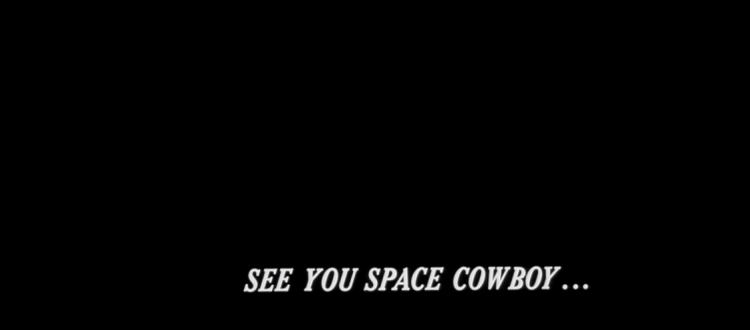








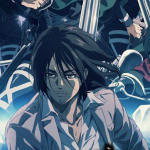
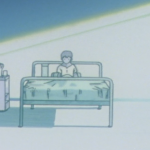
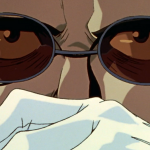
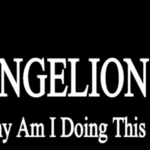
Hi there! I found your blog after watching episode 5 two days ago. I, like many others, decided to finally cross off the list something I had been meaning to watch the last thing on my to-watch list I made back in 2009, and unexpected non-rona illness helped move that along nicely. Also moving it along was my choice NOT to play Cyberpunk 2077, because of its decidedly anti-punk slant.
Ever since, I would read your review after watching each episode to see if my own thoughts matched up with yours. For the most part, they tracked.
(Side note here: You’re apparently only one of six sources who have ever transcribed the interstitial text found in episodes 5 and 6, according to Google. That’s how I found you.)
My favorite episodes were Asteroid Blues (1), Waltz for Venus (8), Jamming With Edward (9), Bohemian Rhapsody (14), and Brain Scorcher (23). They were astoundingly perfect self-contained dramas. Toys in the Attic (11) and Cowboy Funk (22) also landed for me as absurdist comedy episodes.
Your many many comments about the main characters being deprived of agency echoed my thoughts of the series prior to finding your reviews. Around the end of episode 25, I had a theory, almost a revelation about Cowboy Bebop, which I was content enough at the end of episode 26, and I’d like to share it with you:
I believe the main characters are extras in other people’s stories. Some of those stories stick, others don’t land.
I believe that’s why we don’t get any substance to Spike’s relationship to Julia. We aren’t privy to that, because it’s not their story.
Even the stories about Faye, Edward, Ein and Jet focus on the lives and stories of other characters. Sure, they get some backstory involvement with them, but that isn’t central to the -here- and -now- of those other characters’ stories. As you’ve done in your Shaftoe Viewing Order, you try to condense each main character’s story. I would contest that this is the opposite of what works for the series. Cowboy Bebop donates maybe a total of 5-10 minutes each strictly to the main characters advancing their own storylines instead of others’. And that’s across the entire series.
Consider the actions they take for themselves instead of for other people, and I feel one will likely come up with a small handful of sand.
The bounty hunters aboard the Bebop could be replaced with any other highly skilled hunters that lack the foresight to care about what their funds are like at the end of a session. But that wouldn’t make for a cohesive series. In order to tell 20 different stories from this universe they came up with, they’d need a stock cast to be involved in each episode, too. Hence, we have a gang of nobodies doing grueling work and sating their own vices as set dressing.
Does this make Cowboy Bebop bad? No, a lot of other self-contained things do that at times. But, as Watanabe wanted Cowboy Bebop to be treated as a series of short films, I think looking at it from the main cast’s perspective is the wrong way to do it.
It’s as if the series is saying to the main cast, “Ignore them; they’re not important.”
Upon reflection, I think this is why the best episodes work. The crew aboard the Bebop are extras in the real main characters’ stories.
Thank you for writing 30,000 words on Cowboy Bebop! You were like a spiritual guide on the late-train to nowhere.